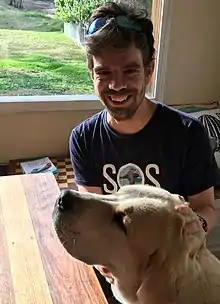Alexander L. Bond
Alexander L. Bond is a Canadian conservation biologist, ecologist, and curator. He is a senior curator at the Natural History Museum at Tring.[1]
Alexander L. Bond, PhD | |
|---|---|
 Alex Bond in Australia in 2018 with CAO dog | |
| Born | Canada |
| Education | Mount Allison University (B.Sc.)
University of New Brunswick (M.Sc.) Memorial University of Newfoundland (Ph.D.) |
| Occupation(s) | Conservation scientist and Principal Curator at the Natural History Museum at Tring |
| Employer | Natural History Museum at Tring |
Education
Bond completed a B.Sc. with honors in biology from Mount Allison University in 2005 and published a thesis titled Daytime spring migrations of scoters (Melanitta spp.) in the Bay of Fundy. He earned an M.Sc. from University of New Brunswick in 2007.[2] His thesis was entitled Patterns of mercury burden in the seabird community of Machias Seal Island, New Brunswick.[2] Bond completed a Ph.D. in 2011 at Memorial University of Newfoundland. His thesis there was called Relationships between oceanography and the demography & foraging of auklets (Charadriiformes, Alcidae: Aethia; Merrem 1788) in the Aleutian Islands.[2] He was a NSERC Visiting Fellow in Government Laboratories, Environment and Climate Change Canada, Canada from 2013 – 2014[3] and a NSERC post-doctoral fellow at the University of Saskatchewan from 2011 to 2013.[4]
Career
Bond is a conservation biologist with a focus on the marine environment and island biology. His current specialisations include conservation, contaminants, invasive species, plastic, seabirds and stable isotopes.[4] He was a NSERC visiting fellow at Environment and Climate Change Canada from 2013 to 2014. From 2014 to 2017, he was a senior conservation scientist for the Royal Society for the Protection of Birds at the Centre for Conservation Science. Bond was an adjunct professor at the University of Saskatchewan School of Environment and Sustainability from 2014 to 2019.[5] until 2023 he was an honorary researcher at the Institute for Marine and Antarctic Studies and is a primary research member of the Adrift Lab, both based in Tasmania, Australia.[6] Bond is a senior curator of birds in the department of life sciences at the Natural History Museum at Tring.[4]
Since 2012, Bond is a subject editor of Avian Conservation and Ecology.[4]
In 2020 Bond and Beth Montague-Hellen shared the Royal Society Athena Prize for his work with LGBTQ+ STEM.[7] In 2020, he took part in the inaugural QatCanSTEM[8] colloquium at Dalhousie University in Canada.[9]
Bond is most noted for his work on plastic pollution in oceans[10][11] and especially the health effects on seabirds.[12][13][14][15][16]
References
- "Dr Alex Bond | Natural History Museum". www.nhm.ac.uk. Retrieved 16 October 2023.
- "Alexander Bond". University of the Highlands and Islands. Retrieved 12 February 2020.
- "Alex Bond – The Environmental Research Institute". Retrieved 12 February 2020.
- "Dr Alex Bond | Natural History Museum". www.nhm.ac.uk. Retrieved 26 July 2019.
- "Dr Alex Bond". Dr Alexander Bond. 20 June 2013. Retrieved 12 February 2020.
- "Adrift Lab". Adrift Lab. Retrieved 12 February 2020.
- "Royal Society Athena Prize". Royal Society. Retrieved 28 October 2020.
- "Queer Atlantic Canadian STEM". Queer Atlantic Canadian STEM. Retrieved 13 February 2020.
- "'We exist': Conference celebrates queer voices in STEM". The Signal. Retrieved 13 February 2020.
- Lavers, Jennifer L.; Bond, Alexander L. (6 June 2017). "Exceptional and rapid accumulation of anthropogenic debris on one of the world's most remote and pristine islands". Proceedings of the National Academy of Sciences. 114 (23): 6052–6055. Bibcode:2017PNAS..114.6052L. doi:10.1073/pnas.1619818114. ISSN 0027-8424. PMC 5468685. PMID 28507128.
- Serra-Gonçalves, Catarina; Lavers, Jennifer L.; Bond, Alexander L. (5 November 2019). "Global Review of Beach Debris Monitoring and Future Recommendations" (PDF). Environmental Science & Technology. 53 (21): 12158–12167. Bibcode:2019EnST...5312158S. doi:10.1021/acs.est.9b01424. hdl:10141/622605. ISSN 0013-936X. PMID 31577441. S2CID 203652001.
- "Ocean plastic is changing the blood chemistry of seabirds". www.nhm.ac.uk. Retrieved 13 February 2020.
- "Ocean plastic affecting shearwaters' blood chemistry, study finds". Oceanographic. 31 July 2019. Archived from the original on 13 February 2020. Retrieved 13 February 2020.
- "Seabirds that eat plastic—and live—have major health problems". Environment. 2 August 2019. Retrieved 13 February 2020.
- Lavers, Jennifer L.; Hutton, Ian; Bond, Alexander L. (6 August 2019). "Clinical Pathology of Plastic Ingestion in Marine Birds and Relationships with Blood Chemistry". Environmental Science & Technology. 53 (15): 9224–9231. Bibcode:2019EnST...53.9224L. doi:10.1021/acs.est.9b02098. hdl:10141/622560. ISSN 0013-936X. PMID 31304735. S2CID 196613959.
- Lavers, Jennifer L.; Hutton, Ian; Bond, Alexander L. (1 August 2018). "Ingestion of marine debris by Wedge-tailed Shearwaters (Ardenna pacifica) on Lord Howe Island, Australia during 2005–2018". Marine Pollution Bulletin. 133: 616–621. Bibcode:2018MarPB.133..616L. doi:10.1016/j.marpolbul.2018.06.023. hdl:10141/622374. ISSN 0025-326X. PMID 30041356. S2CID 51714417.
![]() This article incorporates text published under the British Open Government Licence:
This article incorporates text published under the British Open Government Licence:
External links
- Official website
- Alexander L. Bond publications indexed by Google Scholar